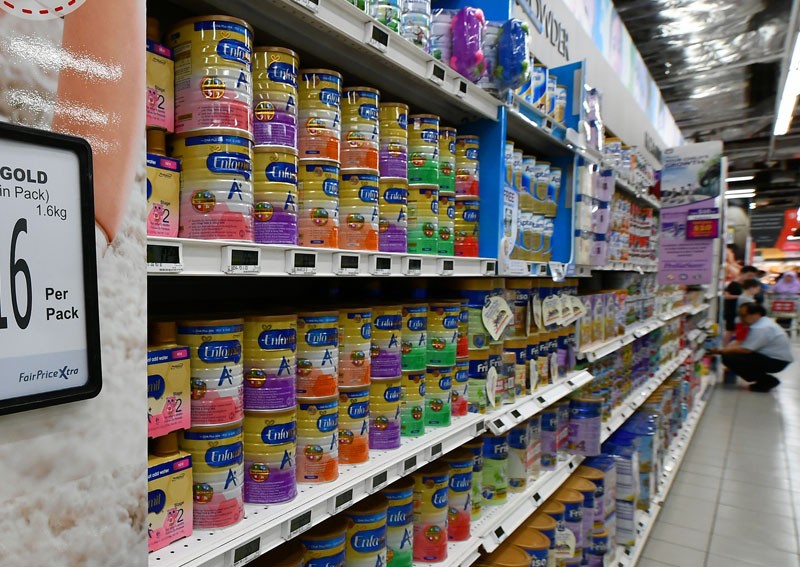Formula race for baby milk

Parents today pay more than two times what they did for infant formula 10 years ago. A 900g tin costs an average of $56, compared with about $25 in 2007.
It is a hefty rise, considering that over the same 10-year period, the cost of fresh milk went up just 6.8 per cent to $2.81 for a 1-litre pack.
Ms PeiRu Ng, 30, who is in public relations, spends $240 a month on about four tins of formula for her six-month-old daughter.
She said: "I choose to breastfeed as I'm aware of the advantages. However, I have been supple- menting with formula as my supply doesn't meet her needs fully, especially since I've gone back to work."
Market research firm Euro- monitor reported that formula milk sales were valued at US$47 billion globally in 2015, fuelled mainly by the growing number of women going back to work after giving birth.
FORMULAS ARE LARGELY SIMILAR
All infant formula sold in Singapore must comply with the requirements of the Agri-Food and Veterinary Authority's Sale of Food Act.

This includes the minimum and maximum nutrient composition in an infant formula, said Ms Natalie Goh, the chief dietitian at Mount Elizabeth Novena Hospital.
Infants should be given only breast milk in their first six months. After that, complementary foods should be given, in addition to breast milk (or formula, if breast milk is not available).
When your baby is a year old, there is no need for formula milk as whole cow's milk can be given.
Fresh cow's milk, or any alternative milk sources, should not be fed during a child's first year. The essential nutrients in infant formula are protein, fat, carbohydrate, vitamins and minerals such as iron, calcium, phosphorus and zinc.
Read also: Man arrested for serial theft of milk powder
What manufacturers do is to formulate a substitute that most resembles breast milk, experts said.
"Standard infant formulas are developed to be as close to breast milk as possible," said Associate Professor Marion Aw, a senior consultant at the division of paediatric gastroenterology, hepatology and nutrition at National University Hospital.
"The calorie content and nutritional composition, such as protein, fat and carbohydrates, are more or less similar across all brands."
All standard infant formulas contain added ingredients that are found in breast milk, said Prof Aw. These include DHA (docosahexaenoic acid), AA (arachidonic acid), special nucleotides and oligosaccharides. "They are thought to be important for brain development and immunity, as well as promoting a healthy gut," Prof Aw added.
Ms Goh said some brands add certain nutrients to differentiate themselves from others. For instance, some incorporate lutein, a type of carotenoid with antioxidant properties that is thought to protect eye tissues from damage.
But unless the baby has a medical condition that warrants the use of specialised infant formula, choosing a formula based on its nutrient composition is unnecessary.
WHICH BRAND IS BEST?
Many formula milk brands for newborns cost between $50 and $60 for a 900g tin in Singapore.
There is no evidence that one company's milk is better than another, so parents need not stick to one brand, according to the Unicef UK Baby Friendly Initiative.
The minor differences that exist may affect the baby's tolerance level. So, if one brand disagrees with your baby, try another one.
Prof Aw said there may be cornstarch added to infant formulas to make them a little thicker. These are for babies who may have issues with vomiting and reflux.
There are also formulas that claim to help hungry babies and prevent colic, wind or allergies.
But there is no evidence that they do any good, according to the Unicef UK Baby Friendly Initiative.
However, what goes into infant formula has changed over the decades.
"If you compare the composition of the formulas today to one from 50 years ago, the current formulas have less protein, and a different amount of carbohydrate and additional nutrients," said Herbalife Nutrition Advisory board member Nathaniel Viuniski, who is a childhood obesity expert.
Although the protein content has been reduced, it is still higher than that of breast milk, said Prof Aw. The average protein content in breast milk is 1.1g to 1.3g per 100ml, while infant formula has 1.2g to 1.7g per 100ml, she said.
BREAST MILK CAN'T BE RECREATED
What breast milk has, which formula milk does not, are "living" components and antibodies from the mother. It also contains traces of antigens from the food and drink that she takes.
"The taste of breast milk may subtly vary from day to day, depending on what mum is eating and drinking," said Prof Aw.
Breast milk, said the World Health Organisation, contains antibodies that help protect infants from illnesses such as diarrhoea and pneumonia, the two primary causes of child deaths worldwide.
Another benefit of breastfeeding is that it is difficult to overfeed an infant, said Prof Aw. "With bottle- feeding, it is easier and more tempting for caregivers to have babies finish a fixed amount of milk."
Read also: Parents shocked by rising milk powder prices
Breastfed babies not only have a lower risk of infections, but they are also less likely to be obese.
Human milk has the perfect nutritional balance in terms of proteins, carbohydrates, fats and amino acids, and is more digestible than formula milk. This protects babies from diabetes associated with obesity, said Dr Viuniski.
Breastfeeding also improves the baby's psychological health due to the bond he shares with his mother during feeding.
However, Prof Aw said: "If mums cannot breastfeed their babies, it is important that we don't make them feel guilty. Infant formulas are a suitable second choice."

This article was first published on Apr 11, 2017.
Get a copy of The Straits Times or go to straitstimes.com for more stories.